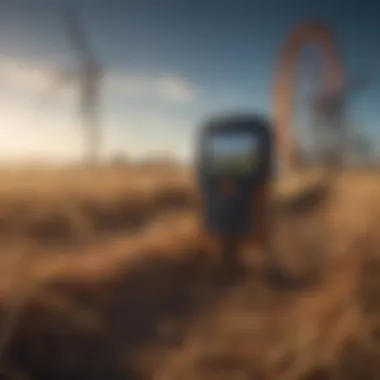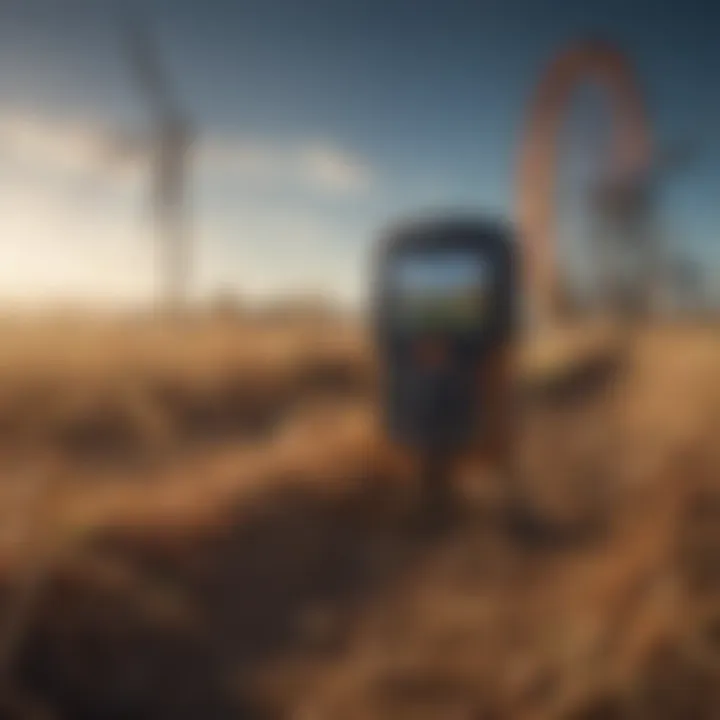Understanding Wind Loggers for Sustainable Farming


Intro
Wind loggers play a vital role in the landscape of modern agronomy, influencing how farmers approach their daily tasks and long-term strategies. These devices measure wind speed and direction, enabling professionals to make informed decisions based on accurate data. In an era when sustainability and efficiency are paramount, understanding how these tools function and their benefits is essential.
Overview of the Topic
Definition and Importance
Wind loggers are instruments designed to capture wind data continuously. Their importance lies in providing actionable insights that support effective agricultural practices. Farmers utilize this information for various purposes, including predicting weather events, managing irrigation systems, and optimizing planting and harvest times. A comprehensive grasp of these devices' operational principles enhances their utility in farming.
Current Trends
Recent advancements in wind logger technology reflect a focus on increased accuracy and user-friendly interfaces. Integration with mobile apps and cloud-based analytics platforms is becoming common. This shift allows for real-time data access and analysis. Furthermore, the trend toward incorporating renewable energy solutions in farming ensures that wind loggers play an integral role in sustainable practices.
"Real-time data from wind loggers allows farmers to respond swiftly to changing environmental conditions."
Key Techniques and Practices
Step-by-Step Guide
Implementing wind loggers involves several crucial steps:
- Selection of Appropriate Logger
Choose a wind logger that suits your specific agricultural needs. Consider factors like data accuracy, durability, and compatibility with existing technologies. - Site Assessment
Identify optimal locations for installation. This involves assessing environmental conditions and potential obstacles, like tall structures or trees. - Installation
Follow manufacturer instructions carefully to ensure that the equipment is set up correctly. - Data Collection
Regularly collect and analyze data to understand wind patterns in your area. - Adjust Practices
Use insights gained from data to adjust agricultural practices, improving overall efficiency.
Tools and Equipment Needed
To effectively utilize wind loggers, the following tools are typically recommended:
- Wind logger device (e.g., Campbell Scientific),
- Mounting hardware,
- Data logging software,
- Mobile application for real-time access to data.
Challenges and Solutions
Common Obstacles
Using wind loggers can present challenges, such as:
- Equipment malfunctions,
- Difficulty in interpreting data,
- High initial investment costs.
Innovative Solutions
Addressing these challenges involves:
- Regular maintenance checks to prevent malfunctions,
- Training for users to help interpret data effectively,
- Considering budget-friendly options or rental agreements for initial trials.
Knowledge of wind loggers is crucial for enhancing efficiency and fostering sustainable practices in agriculture. As the field continues to evolve, adapting to innovations will be key for success.
Prelude to Wind Loggers
The topic of wind loggers holds significant importance in modern agronomy. These devices offer crucial insights into wind patterns and their impact on agricultural practices. Understanding the role of wind loggers enables farmers and agricultural specialists to optimize their operations, improve crop yields, and manage environmental factors effectively. This section will explore the definition and historical context of wind loggers to provide a foundational understanding.
Definition and Purpose
Wind loggers are specialized instruments designed to measure various wind parameters, such as speed and direction. Their primary purpose is to collect data that can contribute to better decision-making in agriculture. By understanding wind behavior, farmers can anticipate its effects on crop growth, pest control, and irrigation management.
The ability to monitor wind conditions allows farmers to adjust their practices. For example, they can time pesticide applications more effectively, as winds can significantly influence drift and deposition. Additionally, understanding wind patterns helps in the design of agricultural landscapes, ensuring that windbreaks and barriers are strategically placed.
Historical Context
The evolution of wind loggers can be traced back to early meteorological instruments. Wind measurement dates to ancient civilizations, which relied on rudimentary methods to observe weather changes. However, it was not until the 19th century that more precise instruments, like anemometers, became common. These early devices marked a transition toward accurate wind measurement, leading to improved agricultural practices.
The introduction of digital technology in the late 20th century revolutionized how wind data is collected and analyzed. Modern wind loggers combine advanced sensor technology with data transmission capabilities, enabling continuous monitoring and real-time analysis. This technological advancement has made it easier for farmers to integrate data-driven approaches into their daily operations, aligning agriculture with modern scientific advancements.
Ultimately, wind loggers represent an intersection of technology and agriculture, providing insights that steer sustainable practices. They are tools that contribute not only to productivity but also to environmental stewardship. As we delve deeper into their technology, applications, and significance, understanding wind loggers will reveal their integral role in enhancing agronomy.
The Technology Behind Wind Loggers
The technology behind wind loggers plays a crucial role in understanding how these devices perform and how their data can be effectively utilized in agronomy. It connects the theoretical underpinnings of wind measurement to practical applications in agriculture. By grasping this technology, farmers and researchers can optimize their strategies and improve outcomes.
Sensor Mechanisms
Wind loggers utilize various sensor mechanisms to gauge wind speed and direction accurately. The most common type of sensor is the anemometer. These devices can either be mechanical, using rotating cups or blades, or electronic, relying on sonic or laser technologies. Each mechanism comes with its unique advantages, affecting their suitability for specific environments.
For instance, mechanical anemometers are typically robust and can withstand harsh conditions. However, they may require more frequent maintenance. On the other hand, electronic sensors offer higher precision and lower operational costs over time.
Factors such as measurement range, response time, and accuracy are vital, as they can significantly affect data collection.
"Reliable sensor mechanisms are key to gaining accurate insight into environmental conditions."
Understanding the operating principles of these sensors allows users to select the most appropriate device for their specific agricultural needs. A good choice can lead to improved crop management and yield.


Data Transmission Techniques
The data collected by wind loggers needs to be transmitted effectively for analysis and interpretation. This is where various data transmission techniques come into play. Most modern wind loggers utilize wireless transmission methods, which may include protocols such as Bluetooth, Zigbee, or Wi-Fi.
Each of these technologies has its strengths and weaknesses.
- Bluetooth is great for short-range communication, making it efficient for small farms.
- Zigbee is useful for extending communication over longer distances with low energy consumption.
- Wi-Fi, although more common, may require robust infrastructure due to its range limitations.
Moreover, some advanced wind loggers incorporate GSM technology for remote monitoring. It allows users to receive real-time data on their devices through mobile networks. This feature is essential in time-sensitive scenarios, where waiting for data collection might result in lost opportunities for intervention in crop management.
In summary, there are critical considerations regarding sensor mechanisms and data transmission techniques, as they can greatly influence the effectiveness of wind loggers in agricultural applications.
Key Features of Wind Loggers
Understanding the key features of wind loggers is critical for agricultural professionals and enthusiasts. These devices offer a nuanced approach to measuring and interpreting wind data. Various factors like measurement range and accuracy, as well as durability, play significant roles in enhancing farming practices and ensuring effective data collection.
Measurement Range and Accuracy
In agronomy, the measurement range of wind loggers refers to the spectrum of wind speeds they can accurately capture. Wind loggers have a varied range, often from low speeds of less than one meter per second up to extreme gusts of over 30 meters per second. Accurate measurements across this entire range provide crucial data to farmers. It allows them to monitor environmental conditions that directly influence crop growth and health.
Accuracy in measurement is equally important. Most advanced wind loggers exhibit precision levels within a few percent of actual wind speeds. This level of accuracy is essential for effective decision-making in agriculture. For example, knowing the precise wind conditions can help in scheduling activities such as planting, applying pesticides, or harvesting. Not only does this enhance crop yield, but it also mitigates the risks associated with wind damage.
Durability and Maintenance Requirements
Durability is a fundamental feature of wind loggers, given their outdoor deployment in various weather conditions. Quality wind loggers are built to withstand rain, snow, extreme temperatures, and UV exposure. Features such as waterproof casings and corrosion-resistant materials are commonplace. This resilience ultimately translates into lower replacement costs and higher reliability in long-term data collection.
Maintenance requirements for wind loggers vary but should not be overlooked. Regular checks are necessary to ensure that the sensors and other components are functioning correctly. Depending on the model, some may require recalibration periodically to maintain accuracy. Additionally, cleaning the sensors can prevent data interference caused by dirt or debris.
"The efficiency of wind loggers directly influences the sustainability of agricultural practices, making understanding their features vital for modern agronomy."
Applications in Agriculture
The integration of wind loggers in agriculture offers significant advantages that extend beyond mere data collection. Understanding their applications is crucial for optimizing farming practices and achieving sustainability. Wind loggers provide real-time data on wind patterns, helping farmers make informed decisions that affect crop management and pest control. This section delves into specific applications, emphasizing their benefits and the considerations necessary for effective utilization.
Wind Patterns and Crop Growth
Wind patterns play a pivotal role in influencing crop growth. They affect temperature, humidity, and, ultimately, photosynthesis. By employing wind loggers, farmers can track local wind conditions and their seasonal variations. This data aids in predicting how wind might impact microclimates within fields.
Benefits of Monitoring Wind Patterns:
- Improved Crop Performance: By adjusting planting schedules based on wind data, farmers can promote optimal conditions for growth. Farmers have realized that planting crops when wind conditions are favorable leads to better growth rates.
- Enhanced Irrigation Management: Understanding wind speed can help farmers optimize irrigation practices, reducing water waste and improving salinity control.
- Data for Crop Selection: Historical wind data allows farmers to select more resilient crop varieties based on the prevailing conditions of their region.
Farmers can refine their strategies with wind logger data. Practical applications can include implementing windbreaks to shield crops from damaging gusts, thus improving yields.
Impact of Wind on Pest Control
Wind influences pest behavior and movement in noteworthy ways. Understanding how wind affects the dispersal of pests can help farmers mitigate their impact. Wind loggers provide essential data that can guide pest management strategies.
Key Impacts of Wind on Pest Control:
- Pest Dispersal Patterns: Wind can carry pests from one area to another. By analyzing wind direction and speed, farmers can anticipate when and where pests may invade.
- Application of Pesticides: Knowledge of wind conditions allows for more efficient pesticide application. Farmers can avoid applying chemicals on windy days, reducing waste and environmental impacts.
- Natural Predators: Certain predatory insects may also ride the wind. Understanding the relationship between wind and pest populations can inform biological control strategies adhering to integrated pest management practices.
Implications for Environmental Monitoring
The implications of wind loggers in environmental monitoring are substantial. These devices serve as crucial instruments that collect data on wind patterns, which has wider effects on various environmental factors. Understanding wind dynamics is imperative for both agriculture and ecological systems. Wind loggers offer a unique perspective that can aid in analyzing climate conditions and biological interactions.
Role in Climate Studies
Wind loggers contribute significantly to climate studies. By recording data on wind speed and direction over time, researchers can observe trends in weather patterns. This data is vital for understanding climate change, as shifts in wind patterns can indicate broader atmospheric changes. For instance, studies have shown that changes in wind can influence temperature variations and precipitation patterns.
- Data Collection: Long-term data from wind loggers help scientists identify variations in climate conditions.
- Impact Assessment: This information is crucial for assessing the impacts of climate change on different ecosystems.
- Predictive Modeling: Accurate wind data enhances models that predict future climate scenarios, benefiting both agriculture and environmental management.
More comprehensively, the integration of wind logging data into climate models enables more precise forecasting. In turn, this supports informed decision-making for climate mitigation strategies.
Applications in Ecological Research
Wind loggers also play a significant role in ecological research. They provide valuable insights into how wind interacts with various species and habitats. Wind patterns can influence seed dispersal, pollination, and even animal migration.
- Habitat Monitoring: Wind loggers help monitor habitats and evaluate how wind conditions affect vegetation growth.
- Biodiversity Studies: Understanding local wind patterns can lead to insights on species distribution and biodiversity levels.
- Ecosystem Dynamics: The movement of air impacts temperatures and moisture levels within ecosystems, affecting their overall health.
"The integration of wind data into ecological research offers a holistic view of habitat dynamics."
In summary, wind loggers are indispensable in environmental monitoring. Their applications in climate studies and ecological research underline their importance for understanding both agricultural practices and larger environmental issues. The continuous collection and analysis of wind data contribute to a more sustainable and informed approach to managing our natural resources.
Data Analysis and Interpretation
Data analysis and interpretation play a crucial role in the effective utilization of wind loggers in agronomy. Understanding wind patterns is essential for making informed decisions that directly affect crop health and yield. With accurate wind data, farmers can develop strategies that optimize resources and reduce waste. This section discusses the significance of data analysis and how it integrates with modern agricultural practices.
Software and Tools for Data Processing


Analyzing the data captured by wind loggers requires specialized software and tools. These programs help transform raw data into meaningful insights. Popular software solutions include ArcGIS, MATLAB, and R. Each offers unique features for visualizing and interpreting wind data. Farmers can use such programs to create wind maps, identify patterns, and assess how wind affects various aspects of farming, including pollination and irrigation management.
Additionally, many manufacturers of wind loggers provide proprietary software tailored to their devices. This software often includes user-friendly interfaces and advanced analytics features. Farmers must evaluate which tools best meet their needs by considering factors like ease of use, functionality, and support.
Some key functionalities to look for in software include:
- Data Visualization: Graphs and charts make it easier to interpret wind speed and direction.
- Comparative Analysis: These tools often allow for the comparison of data across different time frames or locations.
- Alerts and Notifications: Software can provide real-time alerts based on wind conditions that might impact farming operations.
Incorporating these tools into farm management practices does not just streamline operations but enhances productivity as farmers can respond quickly to changing wind conditions.
Statistical Methods for Wind Data
Statistical methods significantly enhance the interpretation of wind data collected by loggers. Understanding the basic statistical principles helps in identifying trends and making predictions. Common statistical techniques used include regression analysis, variance analysis, and time-series analysis.
- Regression Analysis: This method can help to model the relationship between wind speed and crop growth, revealing how changes in wind can impact yields.
- Variance Analysis: Farmers can use this analysis to understand how variable wind conditions affect different aspects of their farming operations, allowing them to adjust practices accordingly.
- Time-Series Analysis: Analyzing data over time helps in forecasting future wind patterns based on historical data. This foresight is valuable for planning planting and harvesting schedules.
A combination of these methods provides a more comprehensive understanding of wind patterns and their potential impacts. By applying statistical tools, farmers can make decisions that align closely with environmental conditions, resulting in better resource management.
Wind loggers provide vital data that fuel intelligent farming decisions. A deep dive into data analysis enables farmers to anticipate challenges and seize opportunities effectively.
In summary, data analysis and interpretation are vital to harnessing the full potential of wind loggers in agriculture. The right software and statistical frameworks empower farmers to draw actionable insights from the data collected, optimizing practices in an increasingly data-driven world.
The Role of Wind Loggers in Sustainable Agriculture
Wind loggers play a critical role in fostering sustainable agricultural practices. Their capacity to provide precise data about wind patterns and their impact on various farming activities can lead to enhanced decision-making. Understanding these elements is essential for farmers aiming to optimize resources and reduce environmental footprints in their operations.
Optimization of Resources
The optimization of resources refers to how wind loggers assist farmers in effectively managing inputs like water, fertilizers, and pesticides. By monitoring wind speed and direction, farmers can determine the best times for planting or applying chemicals. This data helps in aligning agricultural practices with favorable weather conditions, ensuring that resource use is efficient and effective.
For instance, if a farmer is aware of potential wind patterns, they can preprocess soil or sow seeds at optimal times, avoiding unnecessary losses. Consequently, this approach not only saves costs but also enhances crop yield. Moreover, using wind data can guide irrigation decisions, minimizing water use while meeting crop needs adequately.
- Increased efficiency in applying inputs
- Reducing waste associated with over-application
- Improved crop health due to timely interventions
Reducing Environmental Footprint
Wind loggers contribute significantly to the reduction of the environmental footprint in agriculture. This technology aids in minimizing chemical runoff, which might occur from excessive application of fertilizers and pesticides. Knowing the wind conditions allows farmers to apply such inputs precisely and avoid application on windy days, which tends to cause drift and contamination of adjacent areas.
Furthermore, by enabling farmers to time operations more judiciously, wind loggers reduce energy consumption associated with mechanized agricultural practices. Efficient machinery use, driven by data from wind loggers, leads to less fuel consumption.
"Wind loggers provide valuable data to farmers, promoting practices that conserve resources and safeguard ecological systems."
Key aspects of how wind loggers help in sustainable agriculture include:
- Reducing chemical usage and promoting organic practices
- Lowering greenhouse gas emissions from tractors and equipment
- Maintaining biodiversity by preventing overapplication of substances that could harm surrounding ecosystems
Future of Wind Logger Technology
The evolution of wind logger technology stands as a crucial aspect within the broader domain of agronomy and environmental monitoring. Technological advancements in this area are essential for enhancing agricultural efficiencies, providing farmers with sophisticated tools that allow for better decision-making. Understanding the future landscape of wind logger technology can reveal new possibilities for sustainable practices and climate-responsive agriculture. This section will highlight the innovative advancements and integrations shaping the future of wind loggers.
Emerging Innovations
The future of wind loggers is illuminated by a series of emerging innovations aimed at increasing their effectiveness and usability. New sensor technologies are being developed that promise higher levels of accuracy and reliability in wind measurement. For instance, advancements in microelectromechanical systems (MEMS) are leading to smaller, more efficient sensors that can operate in challenging environmental conditions without faltering. These MEMS devices are not only compact but also affordably manufacturable, which could widen accessibility for small-scale farmers.
Additionally, artificial intelligence is making inroads into data analysis. By utilizing machine learning algorithms, farmers can glean actionable insights from vast amounts of wind data. This could help in predicting wind-related events and thus allow for timely interventions in farming practices, be it for crop protection or resource allocation.
Several key elements of these innovations include:
- Enhanced data accuracy through refined measurement tools.
- Real-time data processing capabilities, allowing for immediate responses to changing conditions.
- Improved battery life and sustainability of the devices, reducing dependence on constant maintenance.
In essence, innovations in wind logger technology will result in more nuanced and informed agricultural practices, adapting to the rhythms of nature more adeptly.
Integration with IoT and Smart Farming
The integration of wind loggers with the Internet of Things (IoT) marks a significant leap towards what is termed smart farming. This integration aims at creating a comprehensive framework that connects various agricultural devices and sensors via the internet. Wind loggers, when connected to IoT platforms, allow for the centralized collection of data, making it easier for farmers to monitor wind conditions alongside other environmental factors such as temperature and humidity.
The application of IoT in wind loggers presents several benefits:
- Remote Monitoring: Farmers can access real-time wind data from anywhere, reducing the need for physical site visits.
- Data Correlation: By cross-referencing wind data with other environmental variables, farmers can identify patterns and trends crucial for decision-making.
- Automated Responses: IoT systems can be programmed to trigger specific actions based on wind conditions, such as closing greenhouse vents or deploying protective measures for crops.
Moreover, smart farming practices stimulated by IoT integration pave the way for sustainable agriculture by promoting efficient resource use. It reduces waste and optimizes input costs, making farming more economically viable in the long run.
In summary, the future of wind logger technology is rich with potential, opening new avenues for agricultural practices that are both innovative and sustainable. With ongoing advancements in emerging technologies and seamless integration into IoT ecosystems, wind loggers will likely become indispensable tools for modern farmers.
Challenges and Limitations
Understanding the challenges and limitations associated with wind loggers is crucial. While these devices provide valuable data for agronomy, not all their functions are seamless. Agronomists and farmers must consider various elements that can affect data quality, effectiveness, and the overall investment in such technology.
Technical Challenges in Data Collection


Wind loggers are generally reliable, but they are not without their technical challenges. One major issue is sensor calibration. Many wind loggers must be calibrated correctly to ensure precision. If the calibration is off, data can become misleading. Furthermore, environmental variables such as humidity or temperature can impact sensor performance.
Data transmission also poses its own set of challenges. In remote areas, signal strength can diminish, resulting in data loss. This can create gaps in the reported information, which can be detrimental for ongoing agricultural assessments. Manufacturers are often working on improving the range and reliability of data transmission, but solutions are still in development.
Costs and Accessibility Issues
The acquisition and maintenance costs of wind loggers can be a significant barrier. For smaller farms or agronomists, the investment in advanced wind logging technology might be prohibitive. While prices have generally decreased over the years, high-quality models with advanced features can still be expensive. This predicament limits access for those who might benefit most from the technology.
Training is also an essential consideration. Farmers need to understand how to operate wind loggers effectively. This often requires additional training resources, which may represent still another cost.
Despite advances in technology, understanding and addressing these challenges and limitations is key for maximizing the effectiveness of wind loggers in agricultural applications.
Comparative Analysis of Wind Loggers
In the context of agronomy, a detailed comparative analysis of wind loggers holds significant importance. This assessment allows agricultural professionals and enthusiasts to discern the nuanced differences among various wind logger devices and other weather monitoring tools available in the market. By understanding these distinctions, farmers can make informed decisions that optimize their farming practices and improve environmental observations.
A comprehensive analysis emphasizes several key elements. It explores the different functional capabilities of wind loggers and positions them against other weather monitoring gadgets. Such comparisons reveal unique advantages that wind loggers provide in measuring wind patterns critical to agriculture.
Comparison with Other Weather Monitoring Devices
When comparing wind loggers with other weather monitoring devices, several factors come into play:
- Measurement Specificity: Wind loggers are designed primarily to measure wind speed and direction, while devices like anemometers might serve a broader purpose. This specificity can enhance data accuracy for agricultural applications.
- User-Friendly Data Output: Many wind loggers offer direct data logging and integration features. This allows users to easily access real-time information without needing extra tools.
- Environmental Adaptations: Unlike some conventional weather stations, wind loggers are often more durable and are built to withstand harsh agricultural conditions. With better resistance to dust and moisture, they require less maintenance.
- Cost-Effectiveness: In many scenarios, wind loggers provide a more affordable option for farmers seeking to monitor wind influences on crop health, as they combine functionality and efficiency in a compact design.
In essence, when relativizing wind loggers within the larger context of weather monitoring devices, their specialized features can be advantageous for daily agricultural operations.
Evaluating Different Brands and Models
Choosing the right wind logger necessitates a careful evaluation of various brands and models available on the market. Several considerations aid the decision-making process:
- Reputation and Reliability: Brands like Kestrel and RM Young have established trust in the agricultural community for reliable data collection. Researching user reviews and feedback can provide valuable insights into product performance.
- Sensor Technologies: Different models utilize varied sensor technologies. Those with advanced sensors may offer better precision in readings, which matters significantly for critical agricultural decisions.
- Connectivity Options: It is essential to assess how a model transmits data. Devices with wireless capabilities are often more convenient to use in extensive farming setups.
- Cost vs. Features: Farmers should analyze whether the additional features of a more expensive model are worth the cost. Sometimes, basic models suffice for common agricultural needs.
- Support and Warranty: Evaluating the customer support offered by brands is crucial. Ensuring that a model comes with sufficient warranty can protect an investment against potential failures.
Case Studies: Successful Use of Wind Loggers
Understanding the practical applications of wind loggers is crucial for evaluating their impact in agriculture. This section presents case studies that showcase how these devices have facilitated advancements in farming practices and environmental monitoring. By examining specific examples, we can uncover the benefits and considerations associated with the use of wind loggers in real-world situations.
Agricultural Innovations
Wind loggers have shown to be invaluable in various agricultural innovations. For instance, a notable case involved a farm in the Midwest of the United States that experienced challenges with crop yields correlated to inconsistent wind patterns. By implementing wind loggers, the farmers gathered extensive data regarding local wind conditions, enabling them to adjust planting times and crop selection based on wind direction and speed. This resulted in improved crop resilience and higher yields.
Another example is the use of wind loggers in vineyard management. In a vineyard located in California, wind loggers helped the growers monitor the impact of wind on grape quality. The data indicated that specific wind levels during certain growing stages contributed positively to grape ripening. As a result, the vineyard modified its irrigation schedule and canopy management practices, leading to a notable increase in wine quality and crop output.
Key benefits of using wind loggers in agriculture include:
- Enhanced decision-making based on accurate data
- Better crop management and resource allocation
- Increased resilience against adverse weather conditions
Research Indications
Research indicates that wind loggers play a significant role in ecological and agricultural studies. A laboratory using wind loggers in a biogeochemistry study highlighted the device's capability to track wind speed fluctuations and their correlations with soil moisture levels and nutrient dispersion.
Moreover, a collaborative study by agronomists and meteorologists utilized wind loggers to understand the impact of wind on pest movement and dispersal patterns. The findings demonstrated that knowing wind velocity and direction improved the efficacy of integrated pest management strategies. Farmers could anticipate pest invasions more accurately and respond with targeted interventions, ultimately reducing pesticide usage.
Research implies the following advantages of wind loggers in studies:
- Accurate measurements support informed research conclusions
- Better understanding of interactions between wind and agricultural elements
- Ability to influence policy decisions in farming practices
In summary, it is clear that case studies of wind loggers illustrate their transformative potential in agriculture. These examples highlight how agricultural innovations fueled by wind logger data can lead aspiring farmers to enhance their practices sustainably. Research findings further support these technologies as essential tools for optimizing agricultural productivity.
Epilogue
The concluding section of this article aims to underscore the significance of wind loggers in modern agronomy. Their integration into agricultural practices not only allows for enhanced efficiency but also aligns with sustainability goals. Wind loggers provide farmers with vital data regarding wind patterns, enabling them to make informed decisions. For instance, knowing the direction and speed of wind can influence crop management by optimizing sowing and harvesting dates. Therefore, adopting these devices emerges as a crucial consideration for contemporary agriculture.
Summary of Key Takeaways
Wind loggers serve several important functions within the realm of agronomy. Here are the key takeaways from this article:
- Data Collection: Wind loggers offer accurate and timely data that can improve farming strategies.
- Sustainability: These devices play a significant role in making agriculture more sustainable by informing farmers about optimal practices.
- Technical Advancements: Constant innovations in wind logger technology make them more accessible and efficient for use in various agricultural settings.
- Impact on Crop Yields: Understanding wind's effects on crop health helps in maximizing yields and optimizing input usage.
Looking Ahead
As we consider the future of wind loggers, a few points stand out. The potential for integration with smart farming solutions through the Internet of Things (IoT) enhances their capabilities. This integration allows for real-time monitoring and data analytics, presenting farmers with actionable insights. Moreover, emerging technologies in sensor design and data processing are anticipated to improve the accuracy and reliability of wind measurements. Continued research and development in this field will likely yield even more sophisticated devices, providing farmers with tools to tackle the challenges of a changing climate. The path for wind loggers in agriculture appears promising, with the potential to become even more pivotal for decision-making processes in managing crops sustainably.
Citations of Research and Studies
Citations within this article present a foundation upon which knowledge is built. They demonstrate how the data and insights reflect current research trends and discoveries.
Research papers, such as those published in peer-reviewed journals, provide valuable context and findings. For instance, a study on the impact of wind patterns on crop yield, or how variations in wind speed affect pest control strategies can illuminate significant relationships. Through these studies, agricultural professionals can better understand the mechanisms involved and how wind loggers provide critical insights in real-time decisions. Using specific examples, like the work done by
- Smith, J. (2022): This research paper outlines the correlation between wind flow and microclimates in agricultural settings.
- Jones, A. (2021): This study details the effectiveness of wind loggers in monitoring pest movements.
- Adams, L. (2020): Findings on the role of wind data in sustainable farming practices.
Further Reading and Resources
To enhance their comprehension and application of wind loggers, readers can explore various resources that enrich their understanding. Here are several recommended links:
- Wikipedia: Understanding Wind Data
- Britannica: The role of environmental conditions in agriculture.
- Reddit: Active discussions on the latest agricultural technology trends.
- Facebook Groups: Join communities focused on sustainable farming practices and technology.
These resources provide further depth and context, allowing those interested in wind loggers to engage with diverse perspectives and information.



